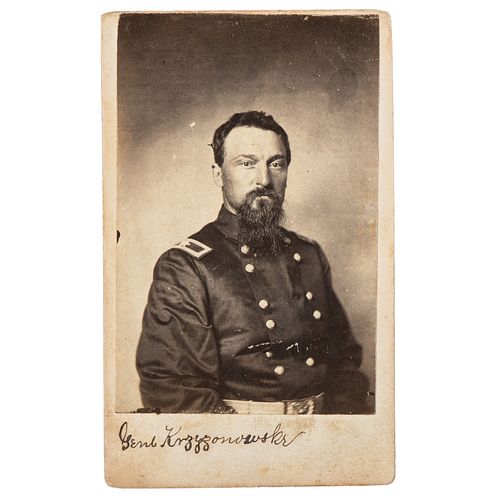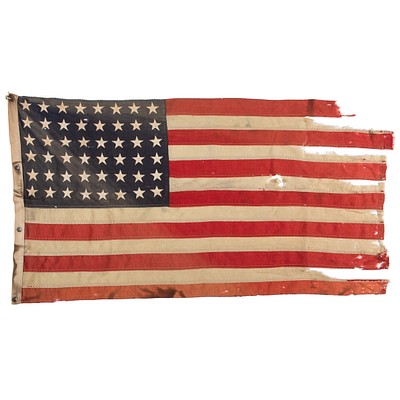CDV of Polish-American Union General W?odzimierz Krzy?anowski
About Seller
6270 Este Ave.
Cincinnati , OH 45232
United States
With offices in Cincinnati, Cleveland and Denver, Cowan’s holds over 40 auctions each year, with annual sales exceeding $16M. We reach buyers around the globe, and take pride in our reputation for integrity, customer service and great results. A full-service house, Cowan’s Auctions specializes in Am...Read more
Two ways to bid:
- Leave a max absentee bid and the platform will bid on your behalf up to your maximum bid during the live auction.
- Bid live during the auction and your bids will be submitted real-time to the auctioneer.
Bid Increments
| Price | Bid Increment |
|---|---|
| $0 | $25 |
| $500 | $50 |
| $1,000 | $100 |
| $2,000 | $250 |
| $5,000 | $500 |
| $10,000 | $1,000 |
| $20,000 | $2,500 |
| $50,000 | $5,000 |
| $100,000 | $10,000 |
About Auction
Jun 26, 2020
Cowan's Auctions is delighted to present the June 26 American Historical Ephemera and Photography Auction, including 55 lots devoted to the African American experience, over 175 lots dating from the Civil War Era, and more than 60 lots documenting life in the American West. Cowan's Auctions dawnie@cowans.com
- Lot Description
CDV of Polish-American Union General W?odzimierz Krzy?anowski
CDV portrait of Brigadier General Krzy?anowski, seated and wearing a double-breasted frock coat, a general officer's sword belt, and a rather serious facial expression. Uncredited. Ink inscription on verso reads, "Genl Krzyzonowski / Comdr of Post / Stevenson / Ala."
Born in Poland, W?odzimierz Krzy?anowski (1824-1887) participated in the unsuccessful 1846 uprising against Prussia and thereafter emigrated to the United States to avoid arrest. By all accounts, Krzy?anowski took the precepts of his new home nation to heart, and was quick to enlist and recruit a regiment of German and Polish immigrants to fight for the Union upon President Lincoln's call for Union volunteers. This regiment, commanded by Krzy?anowski, became known as the "Polish Legion," or the 58th New York Volunteer Infantry Regiment. In the early part of the War, Krzy?anowski participated in the battles of Cross Keys, Shenandoah Valley, and Second Bull Run, where he suffered an injury after his horse fell. In the spring of 1863, the 58th fought stubbornly at the Battle of Chancellorsville as part of General Shurz's Division of the Eleventh Corps, holding the right flank of the Army of the Potomac under Commanding General Joseph Hooker. Though the Eleventh was ultimately crushed and forced to retreat by an attack from Stonewall Jackson, Krzy?anowski was commended for his valiance by General Shurz, other reports, including in the New York Times, attacked the "Germans" for their hasty retreat.
Public and political opinion rarely seemed to be on the side of Krzy?anowski or his immigrant troops. Though General Shurz and President Lincoln recommended his promotion to brigadier general in November of 1862, the Senate failed to approve the nomination before its expiration. Nevertheless, Krzy?anowski continued to fight resiliently for the Union cause. After suffering another horse-related injury and failure on the first day of the Battle of Gettysburg, he led his men in a counterattack on Cemetery Hill the following day to help shore up the Union line. After Gettysburg, the Eleventh Corps was sent west to Tennessee where they fought in the Battle of Wauhatchie from October 28-29, 1863. Even though the battle was a Union victory, it was clear to many that General Hooker had mixed up his orders and caused confusion among brigade positions. According to General Shurz, Instead of taking responsibility for this mix up, Hooker blamed his subordinates, General Shurz and Colonel Frederick Hecker. A court of inquiry, instead of casting blame on two men they knew were likely innocent, made Krzy?anowski the scape goat of the entire affair, again casting the Polish American colonel in an unfavorable light.
Krzy?anowski spent the latter years of the war defending the Nashville and Chatanooga Railroad and commanding the post at Stevenson, Alabama. He was finally brevetted brigadier general in March of 1865, and was given a series of minor appointments by the federal government after the war. He died in New York in 1887, where he was buried until his remains were reinterred at Arlington National Cemetery fifty years later, in 1937. This occasion was accompanied by tributes from US and Polish Presidents Franklin D. Roosevelt and Ignacy Mo?cicki.CDV with surface soil throughout, wear to edges and corners, and some spots of discoloration and possible residue on verso.Condition
- Shipping Info
-
Buyers are required to pay for all packing, shipping and insurance charges. Overseas duty charges are the responsibility of the successful Bidder. Be aware that for larger and/or valuable items, shipping charges can be substantial. - If there is no shipping amount on listed your invoice, you will need to make arrangements to pick up or ship your purchase through an alternative shipping company. Our shipping department can be contacted at 513.871.1670 (ext. 219) or email shipping@cowans.com. - Shipping charges include insurance for your order while in transit. If you have private insurance we will adjust your charge to include only packing and shipping. - Please allow 14 – 21 days after payment to package and ship your purchase as carefully as possible.
-
- Buyer's Premium



 EUR
EUR CAD
CAD AUD
AUD GBP
GBP MXN
MXN HKD
HKD CNY
CNY MYR
MYR SEK
SEK SGD
SGD CHF
CHF THB
THB












